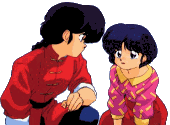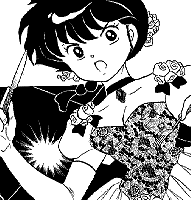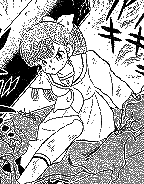Retro Rerun: Ranma 1/2 Manga, Anime
Back in the 1990s Dov Sherman wrote a column for TGForum on Japanese manga and anime. While much of the manga Dov reviewed is no longer available the runaway success of Ranma 1/2 has made it so popular around the world that the manga and anime are always available. Ranma is on interest to us because in the first adventure he falls into a cursed spring and it changes him into a girl. Hot water can change him back into a boy. Think that might make life and love a little difficult? Here is Dov Sherman’s Manga Focus column on Ranma 1/2 from 1997.
Manga Focus by Dov Sherman
Once again, we find the classic tale of a teenage boy cursed to periodically transform into a cute teenage girl, an eternal cliché in the world of transgender fantasy. But this isn’t your usual transgender fantasy or even brown paper-wrapped erotica. It’s mainstream entertainment.
 Ranma 1/2, a long-running manga (Japanese comic book), is the creation of the highly successful manga artist Rumiko Takahashi, perhaps one of the wealthiest wage-earning women on the planet. Appearing in the manga magazine Shounen Sunday, a periodical aimed at boys from grades five to ten, Ranma 1/2 has been one of the most popular manga of all-time both in Japan and around the world with forty compiled volumes comprising more than three hundred chapters. Animation based on the manga has been made into two long-running television series, two movies, and twelve made-for-video specials. Merchandising has included dozens of musical CDs, dolls, models, and video games for several different platforms, including the virtual fighter game Ranma 1/2: Battle Renaissance recently released for the Sony Playstation. English translated comic books and videos are available from Viz Communications and will be for the many years it takes to translate this series.
Ranma 1/2, a long-running manga (Japanese comic book), is the creation of the highly successful manga artist Rumiko Takahashi, perhaps one of the wealthiest wage-earning women on the planet. Appearing in the manga magazine Shounen Sunday, a periodical aimed at boys from grades five to ten, Ranma 1/2 has been one of the most popular manga of all-time both in Japan and around the world with forty compiled volumes comprising more than three hundred chapters. Animation based on the manga has been made into two long-running television series, two movies, and twelve made-for-video specials. Merchandising has included dozens of musical CDs, dolls, models, and video games for several different platforms, including the virtual fighter game Ranma 1/2: Battle Renaissance recently released for the Sony Playstation. English translated comic books and videos are available from Viz Communications and will be for the many years it takes to translate this series.
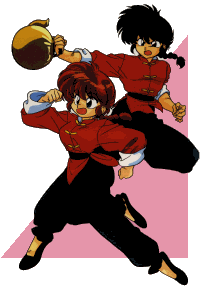 Ranma 1/2, a romantic comedy with a martial arts theme, tells the story of Ranma Saotome (rahn-mah sow-toh-may), a teenage martial artist who has spent the past ten years with his father on a training mission which has taken them all over Japan and China. As the series begins, Ranma and his father arrive at the home of the Tendou family in the Nerima district of Tokyo, Japan, where Ranma is introduced to tomboy Akane Tendou (ah-kah-nay tehn-doh), his fiancée as arranged by their fathers to unite their families. Both being very strong-willed and independent, Akane and Ranma resent the engagement and take an instant disliking to one another (and we all know what that means in the long run).
Ranma 1/2, a romantic comedy with a martial arts theme, tells the story of Ranma Saotome (rahn-mah sow-toh-may), a teenage martial artist who has spent the past ten years with his father on a training mission which has taken them all over Japan and China. As the series begins, Ranma and his father arrive at the home of the Tendou family in the Nerima district of Tokyo, Japan, where Ranma is introduced to tomboy Akane Tendou (ah-kah-nay tehn-doh), his fiancée as arranged by their fathers to unite their families. Both being very strong-willed and independent, Akane and Ranma resent the engagement and take an instant disliking to one another (and we all know what that means in the long run).
However, Ranma has an unusual curse. Two weeks before arriving in Tokyo, Ranma and his father journeyed to Mt.Quanjing in the Bayankala mountain range of China’s Qinghai province where they found Jusenkyou, the training ground of cursed springs. Eager and reckless, Ranma and his father began to train before their guide had explained the nature of the training grounds. Ranma’s father fell into the Shonmaonichuan, the spring of the drowned panda, where two thousand years ago, a panda had drowned and now whoever falls into the spring takes the form of a panda. Ranma fell into the Nuannichuan, the spring of the drowned girl. Now, when doused with cold water, Ranma and his father turn into a cute teenage girl and a panda. Although hot water
can return them to normal, it only takes a sudden rain, a splash from a puddle, or a cup of water to transform their bodies again. While they do retain their original minds and personalities while transformed, their altered bodies present a new host of complications. Ranma himself is terribly embarrassed by and ashamed of his curse and does everything he can to keep it a secret – an attitude which most people in the transgender community have held at some time.
As Ranma settles in at the Tendou home and begins to reach a shaky cease-fire arrangement with Akane, new situations arise. The arrogant and wealthy Tatewaki Kunou, captain of the high school kendou club, has held a long-term but unrequited love for Akane. However, when he meets Ranma’s girl-form (whom he refers to as “the pig-tailed girl”), he falls instantly in love with her. Unwilling to give up Akane, Kunou decides to pursue both girls whom he believes are being held against their will by Ranma.
Further complications arise as Ranma’s junior high school rival Ryouga Hibiki, a strong fighter with an impossibly bad sense of direction, arrives to finish a feud begun over the fight for bread in the school cafeteria. The cast of the series grows to include Kodachi, Kunou’s devious sister and master of martial arts rhythmic gymnastics, Shampoo, a Chinese amazon with a vendetta against Ranma’s female persona, Moose, Shampoo’s nearsighted admirer and master of hidden weaponry, Ukyou, Ranma’s childhood friend and master of okonomiyaki-style martial arts (okonomiyaki is a sort of cross between a pizza and an omelet), and dozens of other characters with absurd specialty forms of martial arts who join the free-for-all battle, forming one-sided loves in a hopelessly tangled web of romantic complication.
Over the course of the series, Ranma finds himself in almost every female role imaginable. With Kunou, he is the object of unwelcome advances. To defeat Kodachi, Ranma takes Akane’s place in the martial arts rhythmic gymnastics tournament, donning a skimpy pink leotard to do so. He teams up with Ryouga to defeat the Golden Pair in martial arts figure skating, donning a revealing, flowery outfit provided by the fashion club. Sentarou, heir to the school of martial arts tea ceremony, kidnaps Ranma, dresses him in a wedding kimono, and announces his plans to make him his bride. Picolette Chardin, heir to the school of martial arts dining, kidnaps Ranma and proposes marriage which Ranma only avoids by defeating him, having to wear a stainless steel corset and a number of flouncy French formal gowns while training. From playboy bunny to cheerleader to waitress to date-bait on the make, Ranma’s inability to turn down a challenge and overly complicated approach to problem-solving thrust him into one lacy ensemble after another.Through her work, manga creator Rumiko Takahashi explores gender in its many aspects by placing characters in unexpected gender roles. Ranma’s curse seems to be almost poetic justice in view of his chauvinistic, arrogant, and macho personality. While Akane seems prideful of her strength and tomboyish behavior, she also has a deep need to prove that she can be feminine and proper, although she is rarely successful. Given Ranma’s own gender issues, he is in a unique position to empathize with Akane’s dilemma although his pride keeps his moments of compassion few and far between, more frequently trading jibes with Akane, referring to her as “uncute” and “unsexy” while she declares him a pervert.
This gender-bending theme carries on through other characters in the series. Ukyou, Ranma’s childhood friend, is a cute teenage girl who, after being jilted by Ranma at the age of five, has lived as a boy for the past ten years. Tsubasa, Ukyou’s admirer, first appears as a mailbox but is revealed as a very pretty young girl and master of disguise. After Ranma and Tsubasa compete to prove who is the prettiest, Tsubasa’s girl-form is discovered to be a disguise as well, although it is his most preferred guise. Although popular with fans, Tsubasa only appears in one manga story, two television episodes, and very brief cameos in the movies and videos. But he is eventually replaced as Ukyou’s admirer by Konatsu, a beautiful but self-effacing, crossdressing ninja.
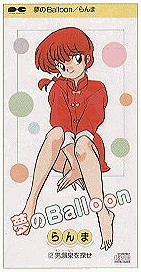 But still the most interesting transgendered character in Ranma 1/2 is Ranma himself with his confusion and frustration over his variant gender as evidenced in the song Yume no Balloon (Dream Balloon) which Ranma sings in the special video Nettou Utagassen (Hot Song Contest):
But still the most interesting transgendered character in Ranma 1/2 is Ranma himself with his confusion and frustration over his variant gender as evidenced in the song Yume no Balloon (Dream Balloon) which Ranma sings in the special video Nettou Utagassen (Hot Song Contest):
The day I first realized the girl inside me
The hem of a skirt…
I went out cheerfully
I’m a little curious about
This fever I have
The feelings I know in my forehead
I know love and dance
The dream balloon of my pretty self is inflating
Look, one popped
Why can’t I see the other boy?
Two people on a park bench, cut in half
This clear day’s date is happy
The feelings I know by my face
Whenever I don’t separate, I step on my shadow
Simple-minded you before the book of the future
Now, the feelings that I saw
I know love and dance
The dream balloon of my pretty self is inflating
Look, one popped
Throughout the future
I won’t separate, will I?
With such a great dearth of positive transgender role models in the Western World, it is heartwarming to see Ranma 1/2, the product of culture with less repressing gender morés, gaining such a strong following for so many years. Perhaps what pleases me the most about Ranma 1/2 is that here, finally, we have something that focuses on a transgender theme with an appeal for a young audience, introducing the impressionable minds of children to transgender situations while they’re still young enough to escape being ingrained with negative views of our community, offering a well-crafted story which portrays transgenderism without resorting to sexual titillation, instead presenting a tale of friendship, love, honor, and the spirit of youth. Thanks to the translation efforts of Viz Communications Ranma 1/2 is reaching the shelves of comic book shops across America and thereby America’s youth. While the American media may dawdle and waffle, offering only the most outlandish and freakish of transgender icons, I’m thankful to have such a great source of joy and humor as Ranma 1/2 available.
View Ranma 1/2 anime at Vis.com.
Moved to make a comment? Login here and use the comment area below.
Category: Transgender Fun & Entertainment



